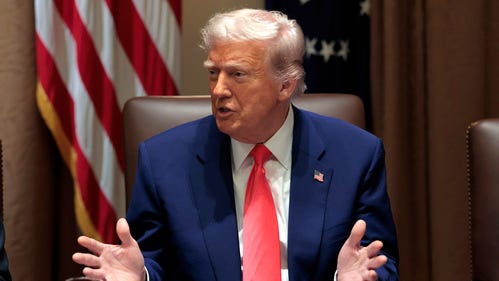After the Retreat: What's Next for Tariffs?
Editor's Note: The recent tariff rollback has sparked intense debate about the future of trade policy. This article analyzes the implications and explores potential scenarios.
1. Introduction
The recent temporary retreat on certain tariffs has left many wondering: what's next? This isn't just about fluctuating trade numbers; it's about the future of global economic stability and national trade strategies. This article delves into the key takeaways from the recent tariff adjustments, examining their impact and forecasting potential future directions for tariff policies worldwide. We'll explore the arguments for and against protectionist measures, analyze the geopolitical implications, and discuss the likely scenarios shaping the future of tariffs.
2. Why This Topic Matters
Tariffs are no longer a niche economic issue; they're a dominant force influencing global markets, supply chains, and consumer prices. Understanding the trajectory of tariff policies is crucial for businesses planning investments, consumers anticipating price changes, and policymakers navigating complex international relations. This analysis provides critical insights for all stakeholders impacted by the fluctuating landscape of global trade. We will examine the short-term effects of recent changes, and consider the long-term consequences for various sectors and economies. Key areas of focus include the impact on inflation, the resilience of supply chains, and the evolving relationship between major economic powers.
3. Key Takeaways
| Takeaway | Explanation |
|---|---|
| Uncertainty Remains High | The recent changes don't signal a definitive end to tariff disputes. |
| Geopolitical Factors are Key | International relations significantly influence tariff decisions. |
| Domestic Political Pressure Matters | Internal political pressures play a significant role in shaping trade policy. |
| Supply Chain Resilience is Crucial | Businesses are adapting to a more volatile trade environment. |
| Consumer Prices are Affected | Tariff changes directly impact the cost of goods for consumers. |
4. Main Content
4.1 After the Retreat: Tariffs' Future
The recent tariff adjustments represent a temporary reprieve, not a resolution. The underlying tensions that fueled these trade disputes remain. The move reflects a complex interplay of factors: shifting economic priorities, domestic political pressures, and evolving geopolitical landscapes.
Key Aspects:
- Economic Impact: The immediate impact includes changes in consumer prices, shifts in production locations, and adjustments in global supply chains.
- Geopolitical Implications: Tariffs are often used as tools in geopolitical power plays, impacting relationships between nations.
- Domestic Political Considerations: Domestic political pressures, including concerns about job losses and economic growth, heavily influence tariff policies.
Detailed Analysis: Analyzing the impact on specific sectors (e.g., agriculture, manufacturing, technology) reveals nuanced consequences. Some sectors may benefit from reduced tariffs, while others may face increased competition or higher input costs. The longer-term effects on investment, innovation, and overall economic growth remain uncertain.
4.2 Interactive Elements on Tariffs' Future
The future of tariffs is not predetermined; it's a dynamic interplay of numerous factors. Several interactive elements will shape the course of future trade policies:
Facets:
- Negotiations and Agreements: Bilateral and multilateral trade negotiations will continue to shape the tariff landscape.
- Technological Advancements: Technological changes may influence supply chains and reduce reliance on specific trade partners.
- Economic Growth and Recession: Global economic conditions will influence the appetite for protectionist measures.
Summary: These interactive elements highlight the complexities involved in predicting the future trajectory of tariff policies, making accurate forecasting a significant challenge.
4.3 Advanced Insights on Tariffs' Future
Predicting the future of tariffs requires considering less obvious factors:
Further Analysis: Expert opinions diverge on the likelihood of further tariff escalations or de-escalations. Some anticipate a continued period of uncertainty, with tariffs used strategically in ongoing geopolitical competition. Others foresee a gradual move towards greater trade liberalization, driven by the recognition of mutual economic benefits.
Closing: The future of tariffs hinges on a complex web of economic, political, and technological forces. A nuanced understanding of these forces is essential for businesses, policymakers, and consumers alike.
5. People Also Ask (NLP-Friendly Answers)
Q1: What is the current state of tariffs? A: The current state is one of relative uncertainty following recent adjustments. While some tariffs have been reduced, the overall trade landscape remains volatile.
Q2: Why are tariffs important? A: Tariffs significantly impact international trade, influencing prices, production locations, and the economic relationships between nations.
Q3: How can tariffs benefit me? A: Lower tariffs on imported goods can lead to lower prices for consumers. However, tariffs can also protect domestic industries and jobs.
Q4: What are the main challenges with tariffs? A: Tariffs can lead to trade wars, disrupt supply chains, increase prices, and harm economic growth.
Q5: How to stay informed about tariff changes? A: Follow reputable news sources, government websites, and trade organizations for updates on tariff policies.
6. Practical Tips for Navigating Tariff Uncertainty
Introduction: Businesses and individuals can take proactive steps to mitigate the risks associated with tariff volatility.
Tips:
- Diversify Supply Chains: Reduce reliance on single sourcing to minimize disruption.
- Monitor Trade Policy Changes: Stay informed about upcoming tariff adjustments.
- Invest in Technology: Automation and technological advancements can improve efficiency and reduce reliance on imported goods.
- Develop Contingency Plans: Prepare for potential changes in trade policies.
- Engage with Policymakers: Participate in discussions and advocate for policies that benefit your interests.
- Hedge Against Risk: Implement financial strategies to mitigate potential losses.
Summary: Proactive planning and adaptability are key to navigating the uncertainty surrounding tariffs.
7. Summary
The future of tariffs is a multifaceted issue shaped by economic, political, and technological forces. Uncertainty persists, but proactive measures can help mitigate the risks associated with tariff volatility.
8. Call to Action
Ready to dive deeper? Subscribe for more insights on the evolving global trade landscape and its impact on your business.

